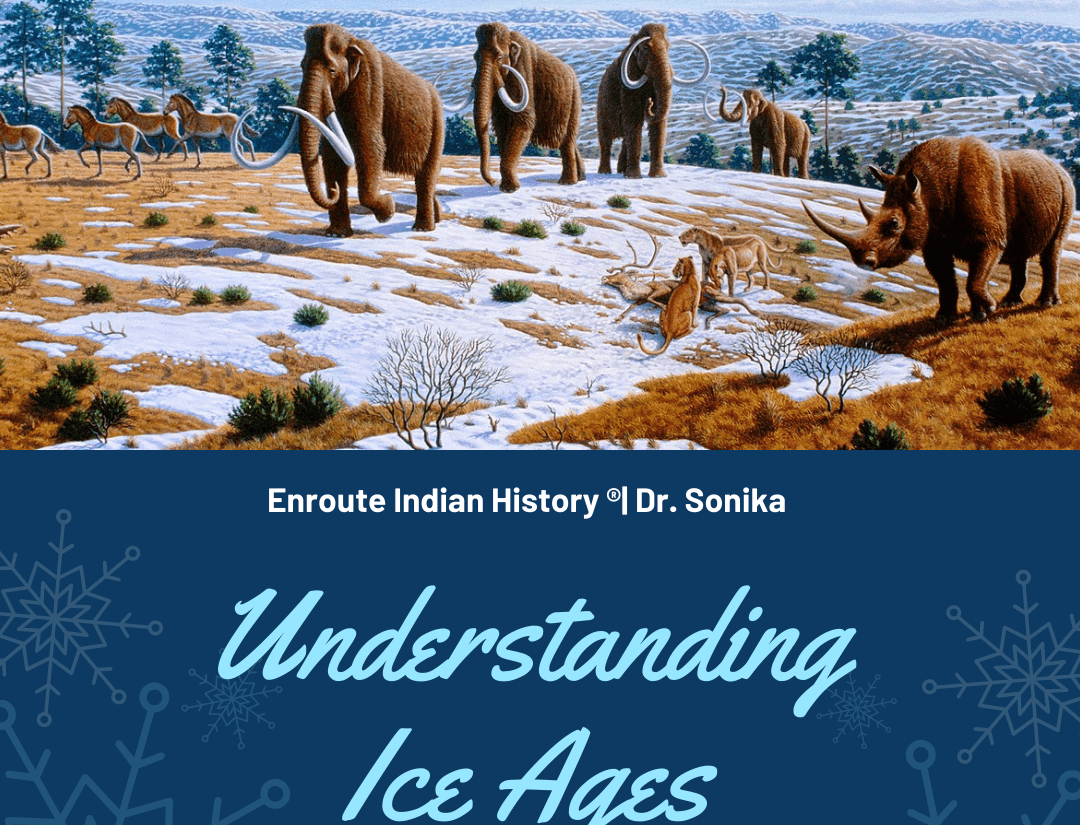
Article by EIH Subject Expert
Dr Sonika Sandhu
An Ice age is a period of prolonged intense cold lasting from a few hundreds to thousands of years in geological time. The main defining feature of ice ages is the extension or presence of polar ice sheets and their recurring advancement and retreating on the continents.
To understand better let us look into our planet’s past. Earth was formed approximately 4.5 billion years ago and since then many events have shaped it to what we see today. Ice ages are also form part of the repertoire of such events. Till 0.9 billion years Earth had no ice, the major glaciation events occurred between 900-600 million years ago. From 600 million years to about 100 million years ago generally mild climates were the norm with intermittent ice forming events. Geological periods such as Precambrian, Late Ordovician-Silurian, Permo Carboniferous all had distinct ice ages within them. Overall there have been at least five well established ice ages in Earth’s history: Huronian, Cryogenian, Andean-Saharan, Late Palaeozoic, and Latest Quaternary
At around 50 million years ago, the Earth started experiencing gradual cooling drying periods leading to the formation of the Antarctic ice sheets. Today we are in what is called as the Quaternary ice age which is characterized by successive and cyclic cold and warm periods termed as glacial and interglacial cycles. The Quaternary ice age started at 2.58 million years ago and ever since Earth has been undergoing cycles of glaciation events with the ice sheets advancing and retreating on 40,000 to 10,00,00 year time scales. We are presently in an interglacial period which began around 10,000 years ago.
Many theories and models have been proposed to explain the ice ages. These explanations range from astronomical theories to tectonic plate movements. Some of proposed explanations are:
- One theory talks about external climate factors and events such as Sun’s output, radiation received by the earth and changes in the concentration of the interstellar dust. These form the basis of many astronomical theories and models.
- Another theory discusses the seasonal and latitudinal distribution of incoming radiations from Sun, and the difference in the intensity based on the changes in Earth’s orbital geometry. Again this is factored in while discussing and designing astronomical theories and models.
- The volcanic dust concentration is also said to be possibly a causative of ice ages. After a particularly catastrophic volcanic eruption, a volcanic winter sets in which drastically reduces the surface temperature as the sunlight is unable to penetrate and reach. This may also be a precursor.
- Some believe that Earth’s magnetic field is also responsible for ice ages.
- The distribution of carbon dioxide between atmosphere and ocean can also affect ice ages.
Out of all these, astronomical theories have gained the most ground and acceptance. There are four main basic steps for any astronomical theory for ice ages:
- The theoretical computation of the long-term variations of the Earth’s orbital parameters and related insolations.
- The design of climate models to study climate changes related to insolation changes.
- The collection of geological data and their interpretation in terms of climate
- The comparison of these proxy data to the simulated climatic variables.
The first of the astronomical observations and explanations were introduced by a Serbian mathematician, astronomer, climatologist, geophysicist and a civil engineer called Milutin Milankovitch. According to Milankovitch, ice ages are a result of insolation changes which effect the surface temperature and over a long period these changes are sufficient to bring about ice ages. The changes basically effect the geographical and seasonal distribution of the sunlight received by the planet. He even successfully calculated the relationship between the summer radiation and the altitude of the snowline, which allowed him to compute the latitude of the ice sheet margin for the last 6,50,000 years. According to him, the summer in the northern latitudes would be colder to prevent the winter snow from melting, this would then allow positive values in the total annual ice budget. This would be a precursor to a feedback cooling system over the surface in turn leading to ice extension. This hypothesis works on the premise that summer insolation is minimum in the high latitude Northern hemisphere. Simply put the Milankovitch theory proposes that the pacemaker of this process is the orbital eccentricity of the earth around the sun (Hays, Imbrie & Shackleton, 1976; Gribbin, 1989) causing major insolation and along with lesser variations in the axial tilt (40000yr) and precession (23000 yr.) producing a complex of climatic oscillations
Milankovitch was not the only scientist to have proposed astronomical explanations for ice ages and paleoclimate changes. Today sophisticated climate models are developed which can accurately test insolation and how its latitudinal distribution effects climate.
Besides astronomical another popular idea to understand ice ages is that of plate tectonics. Throughout geological times, plate tectonics have been responsible for continuous motion and movement of the various land masses, these land masses have been ever since changing their positions with respect to each other and the poles. Of note is that for much of the geological history the poles of the Earth have been ice free, being ice free allows the oceans to circulate around the poles and for them to carry warm equatorial currents leading to an even distribution of heat around the planet. Most researchers agree that around 35 million years ago ice ages became more established, this could be attributed to the breaking of the Antarctic from the South American continent and drifting towards the South pole. The widening of the southern ocean, opening of the Drake passage between Tierra del Fuego and the Antarctic peninsula led to a shift in the ocean circulation, the shift led the Antarctic surrounded by cold circumpolar currents and isolation from the warmer waters coming in from the north.
Another feature of Ice ages is formation of glaciers. Glaciers may have started forming in the Antarctic from around 38 million years ago, leading to alpine glaciation in the higher latitudes of Alaska, Europe and Southern Americas. Of interest is that beginning of the Pleistocene is also marked by formation of widespread glaciation in the northern hemisphere. This event could have closed the Isthmus of Panama thereby closing the seaway connection between the tropical waters of the Atlantic and Pacific oceans. This deprivation and loss of heat from North Atlantic, accompanied by increased precipitation, freezing of the Arctic surface waters would have led to the beginning of an Ice age.
ICE AGES AND HUMANS:
It is hard not to notice that the development and evolution of our species has coincided with the cycles of ice ages since the past 2 to 3 million years. This is not a mere coincidence. The dramatic and extreme climate changes effects innate reactions, development and survivability of individuals and their societies. The larger brain of humans has many key distinct features, one of which is the ability to develop a complex language and be a carrier of information. These two qualities worked in tandem in retention and transmission of experiences and information, this was a huge advantage in our global knowledge bank. On careful analysis of this collective information Ice ages are not the best times for growth of organized large civilizations and cultures. The extreme temperatures lead to lesser mobility and restrictions, food scarcity would be inhibitive, storage would be necessary but also difficult, competition between similar niche species would be higher leading to a control on population, over all survivability would be affected. Ice ages and extreme climate events have been generally associated with breaking up of previous cultures and civilizations as we have seen the effects of the Younger Dryas event of the Neolithic.
However all was not bleak during the ice ages, in the vast Tundra and other such areas humans would have shifted their source of proteins to smaller animals and herding animals, basically numbers mattered more. They favored animals whom they could kill off in large numbers with least resistance and danger. This they did by laying traps and driving them off of cliffs into bogs and lakes. Evidence of this kind of hunting strategy is seen at the foot of a cliff at Solutre in France where remains of 10,000 ice age horses have been unearthed. About 20,000 years ago hunting became more revolutionized by the invention and use of bows and arrows which allowed accurate strikes and increase in the projectile number to hunt. For many species this was devastative and is one of the possible reasons for their extinction. On studying the remains of the people of the ice age societies scientists and researchers have found them to be surprisingly better nourished than many later populations. Some affluent ice age communities were able to feed its members with nearly 5 pounds of food per day. Besides meat they collected a large variety of tubers. High levels nutrition and long days of leisure, unequalled in most successive societies, meant people had time to observe nature think about what they saw. The art of the era is testimony to this. In fact ice age was an era of globalization wherein people all over the world had similar elements and levels of development and progression, they had to deal with similar climatic conditions, people had the same hunter gatherer type of economy, similar foods, similar material cultures and possibly beliefs too.
The present Holocene interglacial is a long summer of climate stability with an increase in the average temperatures by 9 degree Fahrenheit, leading to a rise in the sea levels by 400 feet, the amount of atmospheric carbon dioxide increased by one third. Holocene societies met climate change challenges in different ways as compared to their ice age ancestors, The archaeological record shows that highly integrated or rigid societies, such as the Maya of Central America and the Viking colonies on Greenland, were more susceptible to climate catastrophe than more diverse and flexible ones. The ancient Harrapans of India successfully adapted to weak monsoons and persistent aridity by developing elaborate rainwater harvesting and collecting systems. Till around 8000 years the climate showed considerable variations and instability, it is only in the last 300 years that we have seen a stability in climate and cycles leading to our astounding growth and development in this present age of Anthropocene.
References:
- Hays, James D., John Imbrie, and Nicholas J. Shackleton. “Variations in the Earth’s orbit: pacemaker of the ice ages.” Washington, DC: American Association for the Advancement of Science, 1976.
- Woelfli, W., & Baltensperger, W. (2011). What Caused the Ice Ages?.
- Hewitt, Godfrey M. “Some genetic consequences of ice ages, and their role in divergence and speciation.” Biological journal of the Linnean Society3 (1996): 247-276.
- Wilson, Richard Christopher Lane, et al. The great ice age: climate change and life. Psychology Press, 2000.
- Huddart, David, and Tim A. Stott. Earth environments. John Wiley & Sons, 2020.
- Muller, Richard A., and Gordon J. MacDonald. Ice ages and astronomical causes: data, spectral analysis and mechanisms. Springer Science & Business Media, 2002.
- Fagan, Brian M. complete Ice Age. Thames & Hudson, 2009.
- Gribbin, J. and Gribbin, M. (2002): Ice Age: How a change of climate made us human. Gardners Books; 112p.




















